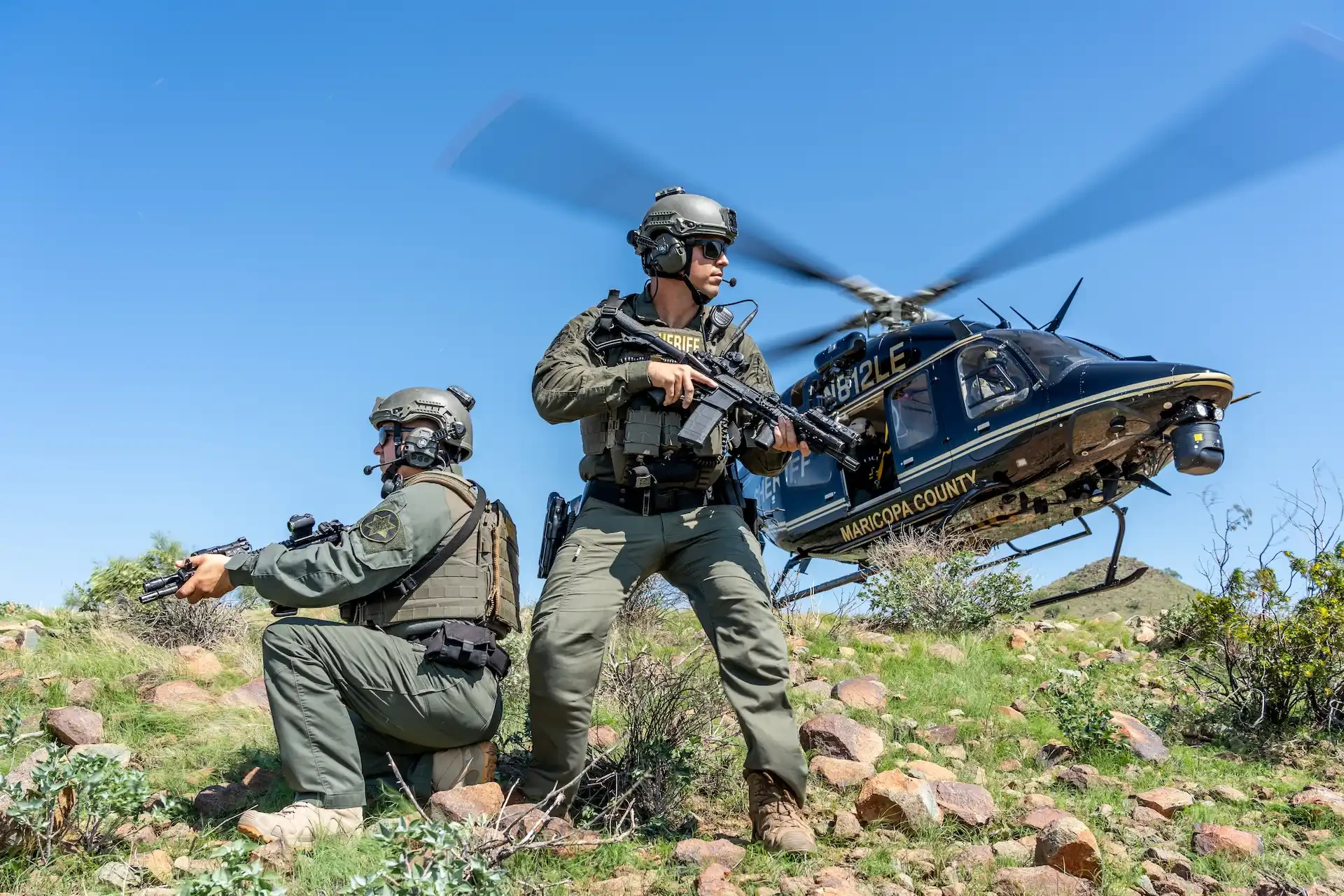Replacing an aging Bell 407 with a brand-new Bell 429 has given the Maricopa County Sheriff’s Office the opportunity to expand its capabilities, particularly in the rescue role. Jason Jorgensen looks at the aviation unit’s newest machine and how it enhances the department’s mission.
Until recently, the Maricopa County Sheriff’s Office (MCSO) in Arizona operated multi-mission Bell 407s. Operational experience in the 9,250 square-mile county revealed the need for a larger, hoist-capable machine and led the air unit to seek a new platform more suited to the demands of the rescue role. Chief pilot Kevin Kraayenbrink explained that although the prime motivator was an enhanced rescue capability, a dedicated rescue ship was never going to be approved.
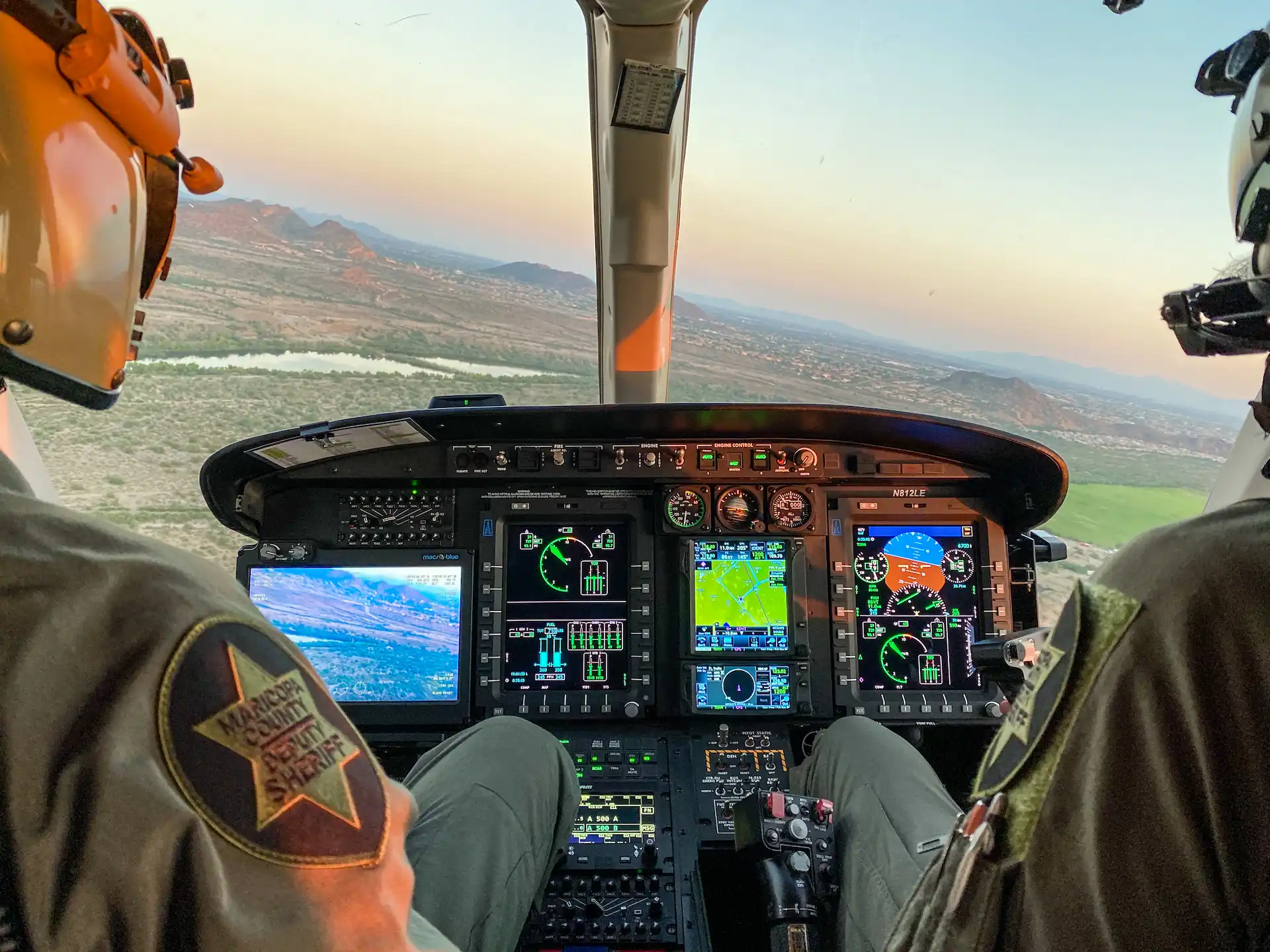
Simple Choice
The selection of a new aircraft type was simplified by several factors. Arizona’s Department of Public Safety (DPS) already operated a Bell 429, having chosen the type after an exhaustive selection and test-flying process from which the 429 emerged as the clear winner. Added to that was the MCSO’s existing experience with Bell products and Bell’s supply and support network, plus the existing tooling on hand for the 407s, much of which is common to the 429. The MCSO hierarchy’s awareness of the DPS machine and its selection process allowed for the issue of a sole-source contract and subsequent purchase of a new 429 for its aviation unit. Following the unit’s practice of honoring fallen deputies’ badge numbers, the new aircraft bears the tail number N812LE, dedicated to Deputy #812 Kenneth ‘Ken’ Blair, killed in the line of duty on 28 Sept 1995.
The sheriff’s office partners with Canadian company Priority 1 Air Rescue for their rescue equipment and training requirements, an extremely practical arrangement as the rescue specialists operate a SAR tactical training academy in Mesa, Arizona. “We purchase all standardized rescue gear from Priority 1 because we use it all in training with them and of course we've also got the 600lb Goodrich hoist,” said Kraayenbrink, who explained that equipment is standardized as much as possible across the fleet to minimize training and operational variation. “We put the same new TrakkaBeam light on the 407 so they match and the FLIR was identical, so we have a spare and can move it back and forth between the aircraft. Hangar One upgraded the 407’s mapping system to match the Churchill system in the new machine, and everything else is just the latest and greatest we can purchase.” Enquiries about the 429 and its equipment have come from all over the world, including a query from Australia about a unique speaker mount, CNC-crafted by Hangar One from a solid billet of aluminium and mounted where the nose-wheel would be fitted in a wheel-equipped example.
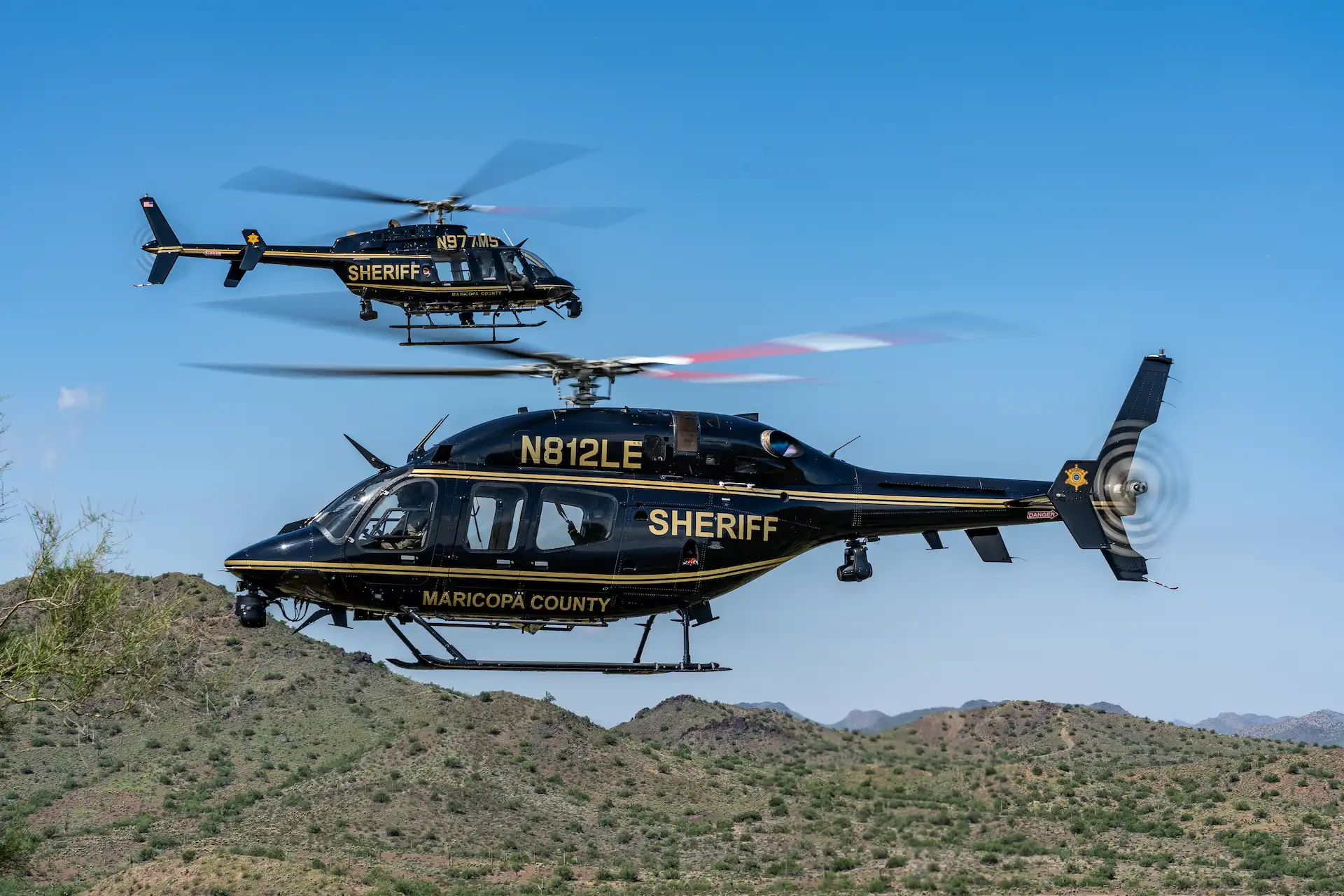
Bell Trained
MCSO crews were all trained at the Bell factory, as close as possible to the new machine’s acceptance date so they could then carry out final transition training and immediately commence operational flying. Bell’s regional sales manager Greg Maitlen remained with MCSO for a while to help and crews then flew the 429 for a couple of months to get some ‘time behind the wheel’, before progressing onto two full weeks of hoist training. Apart from MCSO, DPS and Pinal County also utilize Priority 1 and Kraayenbrink observed that the common approach to training makes for a more seamless rescue environment in which the various agencies can work closely together.
According to Kraayenbrink, training has been one of the greatest challenges faced by the aviation unit since the arrival of the 429, as the unit is somewhat understaffed. “The crews do a phenomenal job and train a couple of times a week. They’re getting really good at what they do but we're short-handed right now. We want a third guy in the 429 full time. We do our best and they're giving us overtime, but we're not fully staffed,” he recounted, adding that members are cross trained across different roles, with pilots also being systems operators, and systems operators being rear seaters or rescue technicians. Incoming aviation unit personnel can be sourced from within the ranks of MCSO’s deputies or come from a civilian or ex-military pilot background. New members traditionally came in as a TFO and progressed over a variety of piston, turbine, rotary, and fixed-wing airframes but the unit no longer operates as wide a variety of aircraft types.
Enhanced Rescue Capability
The 429 significantly enhances rescue-mission safety for the MCSO aircrews, and Kraayenbrink described single-engine rescue as ‘sketchy at best’. “In a single engine aircraft, if the thing burps, you're done. But now we have more power, more room in the back, it’s safer for the crew and safer for the pilot. They're self-contained and can go directly to a hoist job, get all the people out and then just carry on to the next traditional law enforcement call,” he commented. The vastly greater internal capacity is another major boon and Kraayenbrink remarked that where he would barely get off the ground with two extra fully equipped tactical passengers in the 407, the 429 effortlessly takes four in its large cabin, with a flat floor that also permits much more freedom of movement within the aircraft. Kraayenbrink described the new aircraft as basically just a little faster with a full load for day-to-day enforcement missions but noted that its extra power is important for the rescue role. “We have some high altitudes around here, with some peaks around 7,500ft and the 429’s power surplus makes rescues up near those tops a lot easier and much safer.” A satellite phone and cell phone are installed in the big Bell, and the satellite phone is removable so it can be taken out and used away from the aircraft if required.
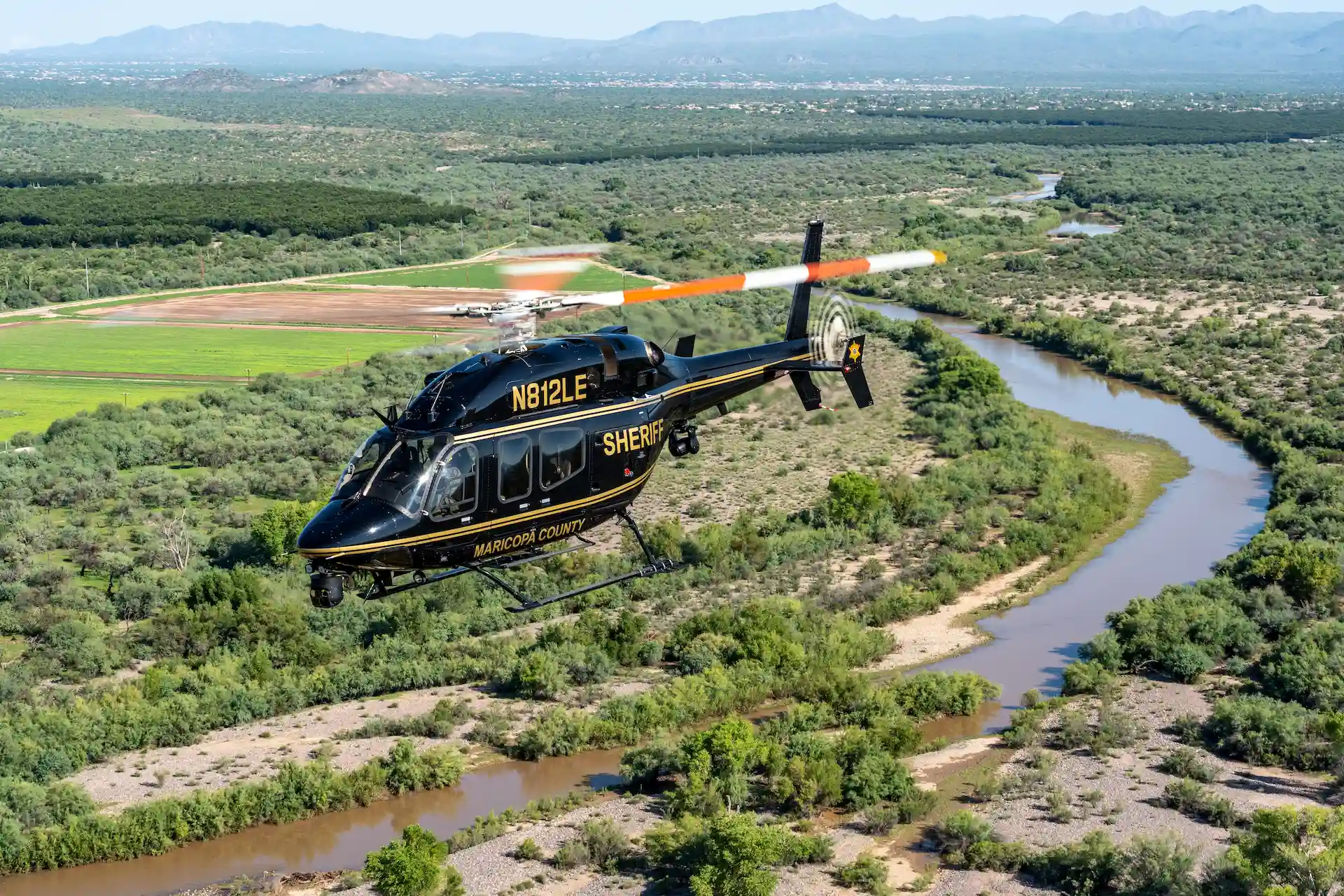
Although rescues are not normally conducted within the city, normal law enforcement operations such as search warrants are a common mission. State police routinely carry out those duties within the city of Phoenix, but the close working relationship means that when the DPS aircraft is down one day a week, and the MCSO machine is down a different day, each assist in carrying the other’s workload. The availability of the hoist has created a demand from numerous fire departments and the unit currently spends significant time demonstrating the aircraft and its capability to those agencies that could benefit from its assistance. “We're still short hauling just like DPS is with only the one 429,” noted Kraayenbrink, “but we help the smaller agencies a lot on traditional police calls and searches, or our dive teams will go into some of these suburban lakes and look for evidence or bodies.” The county is mandated for SAR and so police calls are a relative rarity, compared to a normal law enforcement air unit, with Kraayenbrink remarking that several police calls every shift would be a lot for the MCSO machine. “Phoenix tries to have their aircraft up 24-7, but we’re more like a fire department response.” When they do attend police calls, the aircraft typically operates at 500ft AGL. “We're not getting shot at like in some of these big cities. In LA right now it's 800 to 1000ft and they go down to 500ft for a call, then go back up but we're not seeing that problem yet.” When it comes to rescue calls however, the MCSO unit more than carries its weight. Kraayenbrink advised that when the statistics were last compiled, the sheriff’s unit responded to approximately the same number of calls as DPS, despite the latter having state-wide responsibility.
Innovation and Cooperation
An innovative program has just commenced with the National Guard, after the MCSO asked how it could assist with the Governor’s border-control mandate. The Guard will now provide four medics or EMTs to fly as a third crewmember, one on each of four shifts. The Guardsmen are paired with an MCSO crewmember for training, adding their existing medic skills to the MCSO rescue response capability. The Guard’s new two-star general even paid a familiarization visit to the air unit. “The guys ended up encouraging her into getting in a screamer suit and they hoisted her up. She even went up there and lay down to play the victim,” reported Kraayenbrink. Unlike the DPS, the sheriff’s office unit does not boast advanced life support capability so operates as a dedicated rescue platform, not conducting hospital transfers but transferring patients to an ambulance at the first opportunity.
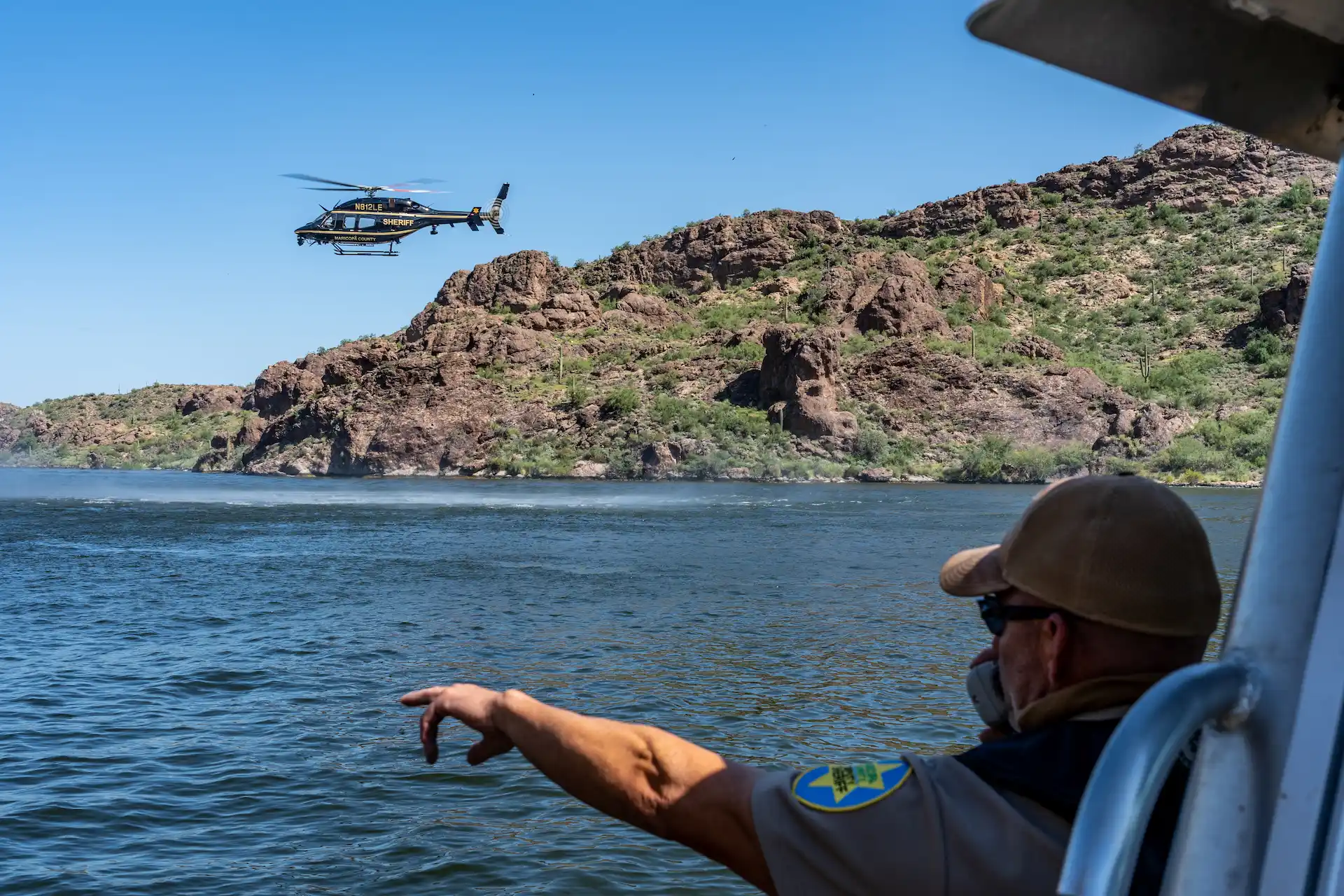
As awareness of the unit’s hoist capability spreads, the demand for a hoist is increasing and Kraayenbrink advised that the unit would like to add another 429 to the fleet. “We need a spare, and three airframes are a minimum for 24-hour service, where we've always been two. Now everyone wants a hoist and it’s becoming more necessary, so our idea is that we would like to keep the 407 here in the unit and get another 429.” The decision to remain with Bell product has been validated with tremendous support from the manufacturer in all aspects of the operation, and Kraayenbrink described the factory support as incredible. The unit’s maintenance personnel are highly experienced senior mechanics and steadily learning the ins and outs of the new type. As for the pilots, engineering training is conducted by Bell and includes a comprehensive range of relevant specialties, including composites, avionics, and major life components in three-week courses. Staff from Bell and Pratt and Whitney also spend time on site, helping and training as needed. “They've been very responsive with spares, repairs, helping us navigate the warranty process and all that stuff,” commented Kraayenbrink. “They act like we have ten of them instead of just one.”
More Power
Kraayenbrink listed the greatly increased power and safety as the features he most appreciated in the new aircraft. “It’s not the end of the world if you lose an engine now. It’s incredibly powerful and everybody always puts too much stuff in, but it's crazy what that thing will carry.” TFO/rescue technician Chris Howard is most appreciative of the hoist, with its added capabilities and challenges. He elaborated, “The capabilities and the amount of training involved is drastically more than with short haul and that's enjoyable. As an SO on short haul, you're just voicing commands and hoping the pilot translates that into an effect on the load, whereas as an SO with the hoist, I can actually have input on what's happening, and I have more control. To me, the hoist is vastly safer, faster, and more conducive to the patient’s health and wellbeing, to get them safely to necessary medical attention.” Howard commented that he particularly enjoyed getting out on the skid or ‘riding the line’ and fellow TFO/rescue technician Chad McBride observed that standing on the skid, hooked to the harness, and operating the hoist has a very different feel to doing short haul, leaning out but hooked in inside the aircraft. “The view, the angle, everything is alien. Two or three hundred feet feels like 1000ft, compared to when you're all safe and snug in here looking down.” Howard added that as a TFO it was easier to get in and out of the aircraft, which also offered much more room to maneuver inside the cabin. He doesn't feel as cramped in the 429 as in the 407 and the only thing that he dislikes is that when trying to clear the tail, it is much harder to see than in the smaller aircraft.
The 429 is equipped with a hoist camera and although McBride only appreciates it for post-mission viewing for training purposes, pilot Rich’ Dickner likes to use it on the job as it lets him visually confirm what he’s hearing from the back. “I like it because I can't see what's going on behind me. I can see before the SO yells at me that I'm going too fast. I can glance at it and see if I start to drift so it just reaffirms what's going on back there for me and,” he explained.
Visual Setup
Although the dual-control 429 is IFR-equipped and capable, only one MCSO pilot is instrument rated and, in any case, the rescue mission requires non-standard, low-level routing and destinations, so does not lend itself to IFR operation. Safety aids include HTAWS and TCAS, plus a go-around button that steadies the aircraft at 75kts and establishes a 750ft/min climb, adjustable on the fly. Dickner pointed out that it offers a one-push solution in the event of a missed approach or a scenario where the pilot needs a few moments to sort things out. The MCSO program relies on multi-capable crewmembers, so TFOs and paramedics are trained to at least the necessary level to take the controls and land the aircraft if necessary. As they also need to move between the cockpit and cabin at times, a cage lid copied from the DPS aircraft has been fabricated and installed over the center console to eliminate the risk of inadvertent damage or activation of switchgear. Hangar One built a one-off command and control center that can be fitted into the 429’s cabin. It incorporates a large screen and accepts various control heads so that, in conjunction with the downlink system, the TFO can handle everything to control major events and incidents.
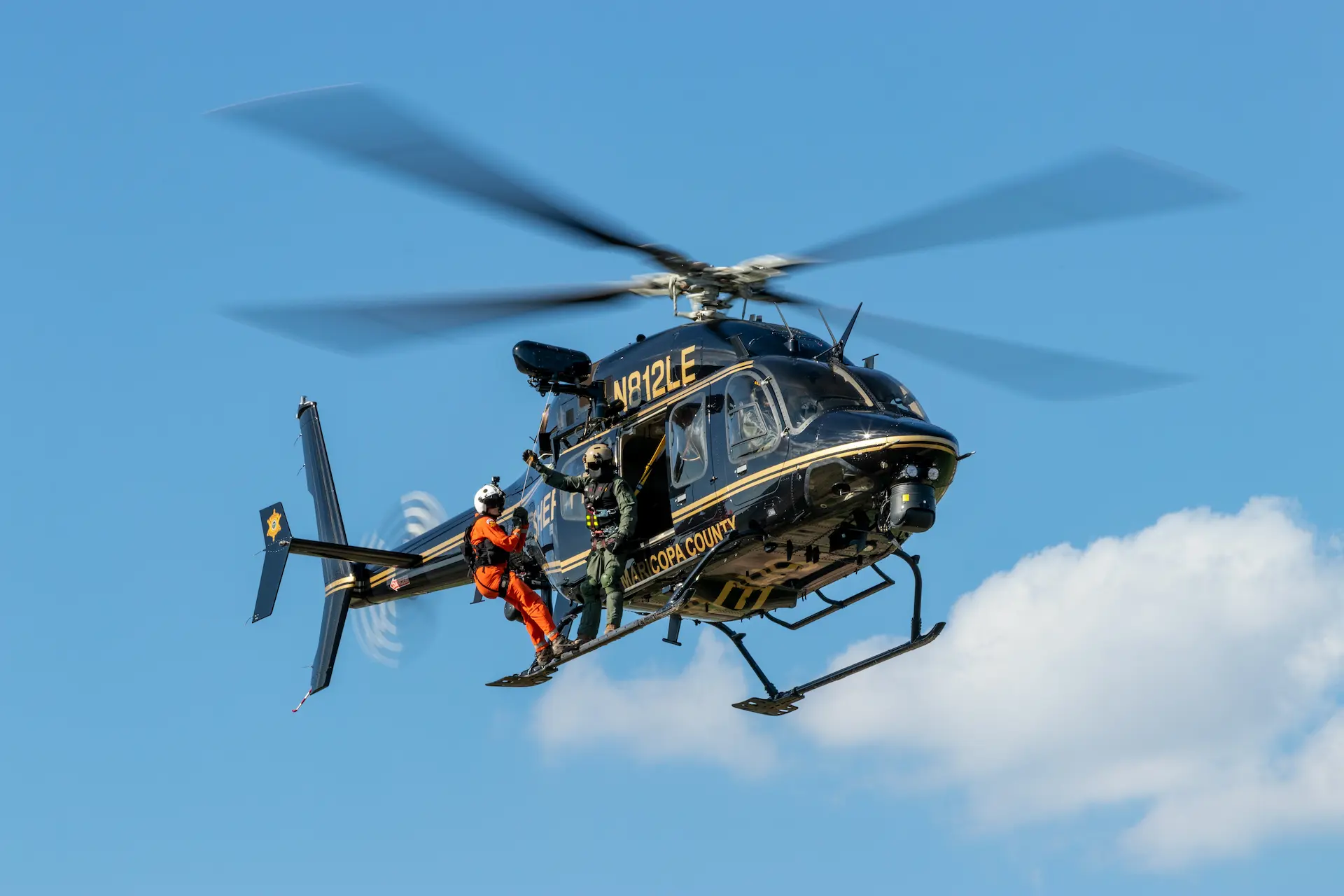
Although there have been a few teething problems since the new aircraft entered service, Kraayenbrink remarked that they have all been relatively minor electronic or computer related glitches. “Even though they're annoying, it's been less than expected for such a complicated build, especially considering that they literally gutted it and rewired it.” Pilots and TFOs all have white phosphorous night vision goggles (NVGs) for night operations, with a few older green phosphorous sets available for crewmembers in the rear cabin. “We wouldn't be able to do our job at night without goggles, we are so far away from any kind of ambient light,” stated Kraayenbrink. “Even in some of these no-moon situations we're able to get in there and get stuff done but the NVGs do make our night program possible.” Red, blue, yellow, white and IR filters are carried for the TrakkaBeam searchlight, and McBride recounted that some MCSO canine units put IR illuminators on the dogs during night operations, minimizing the risk of losing track of the animal while working. Howard added that he believes it would be prudent for all deputies and canines to wear IR lights at night.
Behind the Scenes
McBride opined, “Most people and even most deputies have no clue what we're doing. They want all this information as we're doing this stuff, but we might be monitoring three or four radios, fire’s screaming at us, we've got a boss over here asking about different things. Rich' is yelling at me because I've not got the spotlight on target and the FLIR is off. You're trying to operate all these systems at once and he's trying to land at night on goggles, in a canyon in a dust brownout, and all this stuff is compounding. The general public though, just sees a helicopter come in and land, hook someone up and short haul them out, completely clueless as to how really complicated it is for the pilots and the team.” Now the hoist has been added to the mix, and most agree that the hoist operator’s job is the most difficult in the entire process. Controlling communication, the hoist, cables, and swinging patient, constrained by environment and terrain while remaining fully aware of the airmanship demands, all combine to lead Howard to rate it as the most difficult and demanding task in his extensive military and law enforcement experience, although he acknowledged, “But I just wouldn’t want to do anything else.” He perceives a lack of understanding of the unit’s limitations and capabilities within the ranks of MCSO deputies and would like to see the unit give classes at the Academy, although manpower limitations currently preclude that option.
Funding is Key
Kraayenbrink pointed out that Maricopa County is very well funded, and that any future increase in resources or expansion of the unit is therefore dependent primarily on wider recognition of the program and its capabilities. “We've been doing this for twenty or thirty years,” he commented, “but everything comes down to recognition from our supervisors, all the way to the Sheriff, and to the board supervisors who write the check. We just need to get some more of that funding as we should be a much bigger unit. We should have six helicopters. We have a couple of Cessna’s that we do extraditions with, and they've already agreed they're going to buy us a Cessna Caravan next year, but it's about getting the whole program recognized.”
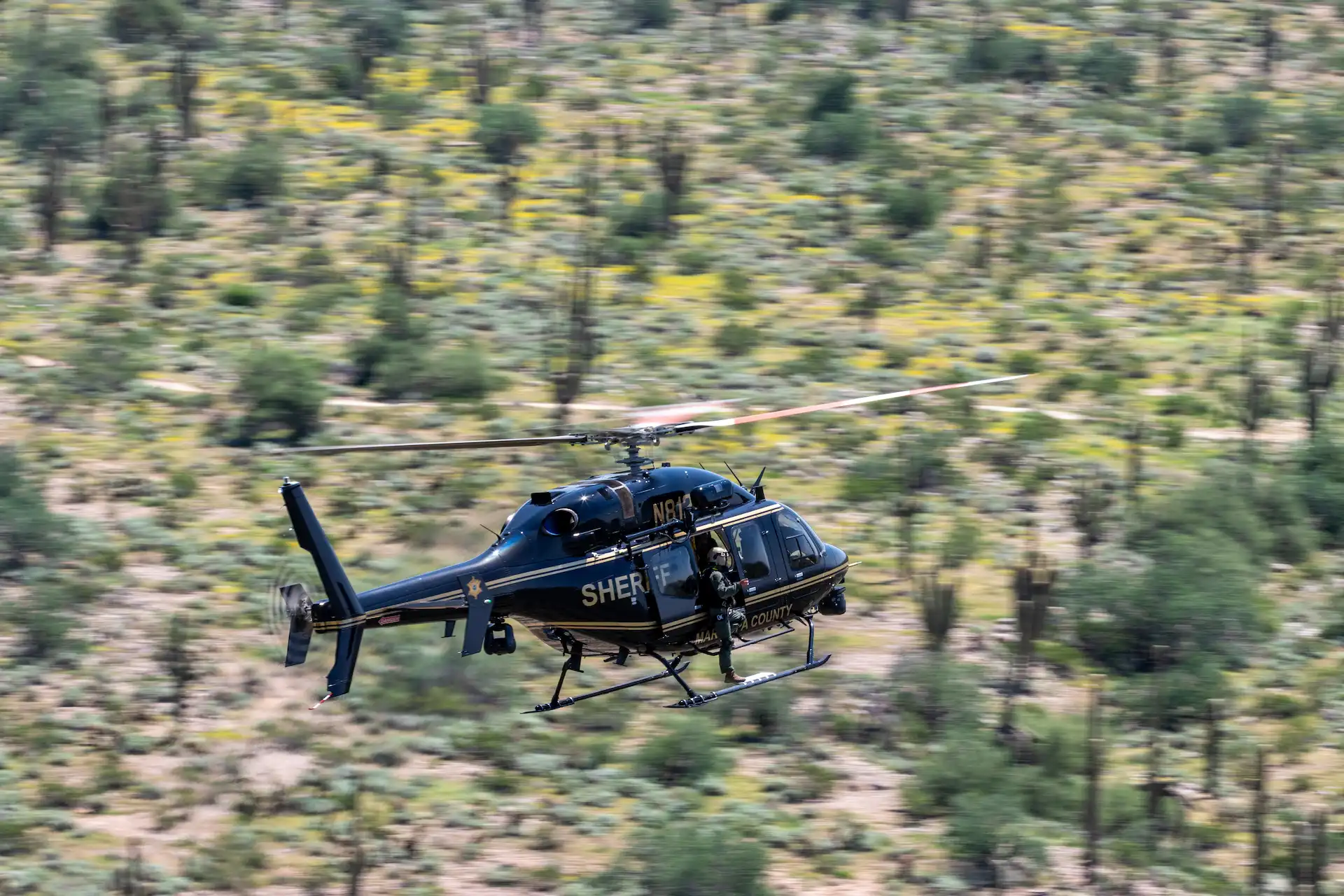
“We need more airframes, more crews. Everything around here can be fixed by cash.” Dickner added that the inherent nature of the unit’s rescue work made it harder to get that recognition. They carry out remote rescues where fire departments are unable to attend, feed patients to an ambulance and depart, leaving a negligible footprint when the same missions carried out by a highly visible air-evac would end up on all the news feeds. “We don’t do it for the publicity, but publicity is needed to get the recognition that facilitates more funding.”
 HOME
HOME


